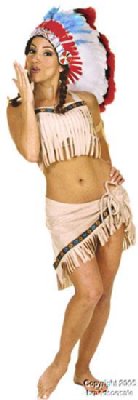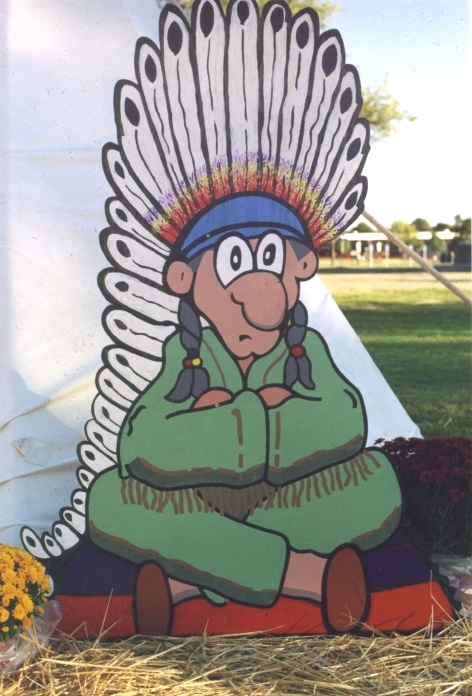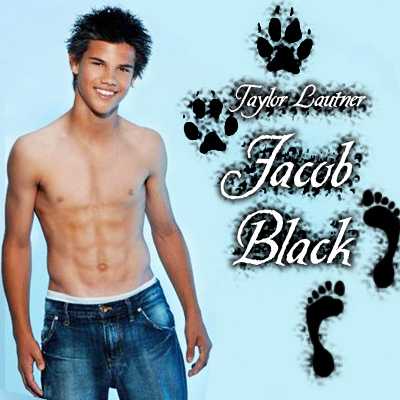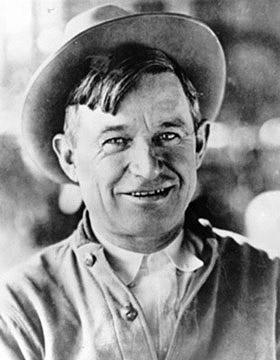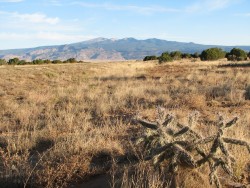One anonymous commenter had slightly more original arguments, which correspondent DMarks and I responded to. This led to the following debate within a debate:
so, you're complaining that people are confusing 'real' and 'mythical' characters, and then getting offended that the costumes don't represent the 'real' versions. obviously they don't; as you yourself said to begin with, halloween is about dressing up as mythical characters.
there's no room for sarcasm or satire in your description, to say nothing of humor or imagination. commenters taking it upon themselves to police other people's true identities are, i'd say, more disturbing than pocahontas outfits.
there's a lot of serious racism out there, and a lot of it comes out to play on halloween. any costume which amounts to kicking its subject while they are down, figuratively speaking, really should be suspect (unless we happen to think they deserve to be kicked... dubya, say). in other words, power differences do matter. but the notion that absolutely any representation involving an ethnicity is automatically racist isn't very helpful. if it is extended to a space alien costume whose only offense is to expose the absurdity of the notion that fellow humans are branded as aliens, you've clearly gone way too far.
dmarks said...
The last anon above this comment said: "but the notion that absolutely any representation involving an ethnicity is automatically racist isn't very helpful."
Is that even relevant? Can you point to even one of these Native-related costumes that is not a blatant stereotype, and thus racist?
I think you'd have a point if there were a bunch of Wilma Mankiller, Chief Joseph, and John Herrington costumes alongside the eternal parade of Chiefs, Squaws, and Braves.
Anonymous said...
the fact that it is *possible* to construe something (eg the illegal alien costume) as racist, does not make it racist, any more than the converse is true--that the fact that it is *possible* to construe a racist costume as satirizing the absurdity of race makes it okay.
the point is that blanket proclamations such as 'all costumes involving ethnically linked representations are racist' aren't, in fact, part of a grown-up discussion of racism. grown-ups have to make distinctions, interpretations, and deal with the fact that if other people don't see it exactly the same way it doesn't necessarily mean either one of you is wrong, or not a 'real' person of color, or 'serious' about the discussion.
Anonymous said...
liv taylor's dad is of cherokee descent. so it's at least partly 'her' identity she's wearing, too.

My response:
No one has said anything like "All costumes involving ethnically linked representations are racist," Anonymous. You know, the straw-man argument you keep putting falsely in quotes?
Brooke made it clear what she was talking about when she wrote:
DMarks reiterated the point when he noted that no one is dressing up as a real Indian--e.g., Wilma Mankiller or John Herrington. If you disagree, post a link to anyone trick-or-treating as a 20th or 21st century Indian. Go ahead...we'll wait.
Tyler is part-Cherokee...so Pocahontas costume is okay?
Hysterically, your comment about Liv Tyler proves our point, not yours. Cherokees didn't wear buckskin outfits like Disney's Pocahontas. Here's what a typical Cherokee looked like:
Sequoyah
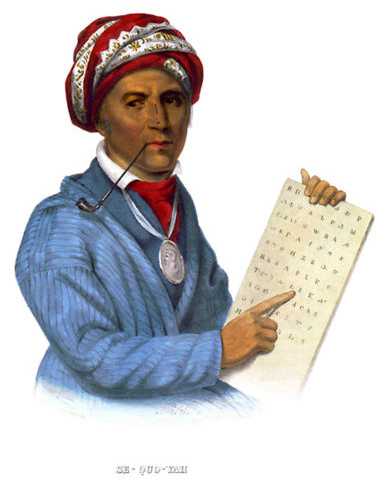
So Liv Tyler's stereotypical costume has reinforced your stereotypical notion of what Indians look like. And you were too ignorant to know the difference. To you, all Indians resemble the caricatures in old Westerns and sports logos.
You either don't know or don't care that Indians come from hundreds of disparate cultures. That they're as different from each other as the people of Ireland, Greece, Russia, Sweden, and Spain. To you, they're all the same.
To reiterate, you thought Liv Tyler = Cherokee = Indian princess = Pocahontas. You thought this because you've seen it in countless Halloween costumes. Thanks for demonstrating so clearly what's wrong with pretending to be an "Indian" on Halloween.
Round 2
rob--to paraphrase joan baez, you know a lot.
you're wrong, of course. the op does clearly extend the argument to all ethnic costumes. it's both implicit and explicit; eg, she states:
"Its not cool to dress up like a Native American, or a person of Asian, Mexican, African decent or any other ethnic group ever lived for that matter!" (sic)
so no straw men were harmed in the making of this argument--at least not from my side.
as for your example of what a 'typical' cherokee looked like: isn't the whole point of this discussion to expose the problems with generalization and stereotyping? you've arbitrarily picked one individual from one specific time period (why not present day? why not 15th century?) as a 'typical' representation. it's no more valid than pointing to a picture of a cowboy wearing a blue bandanna as evidence that a halloween costume using a red bandanna is wrong.
on the other hand, you presume to know a great deal about what i think and where i learned it--all of which happens to be false. you are avoiding several issues brought up in my and others' posts already. the most obvious of which is simply "who decides?" why should i let you decide for me (or for liv tyler, for that matter) what my identity means to me, or what a costume means to that identity? if you want 'authentic' costumes, fine, ban all fancydancing outfits--you've proclaimed them an insult to your (and the wearers') cultures. if on the other hand you admit that culture is a living, changing, heterogeneous thing, perfectly capable of accommodating fancy beadwork and etc., well then, i'm sorry, but neither you nor any other individual is in charge of how exactly it gets interpreted, reinvented, and repurposed.
all of this ignores the initial fallacy of the original posting: as if the point of halloween costumes is to create authentic representations of real people. obviously, it isn't, and never has been, as the op herself initially acknowledged.
there is a genuine racist hazard lurking (sometimes much more than lurking) in some halloween costumes. i think that for those of us who want to do something about it, it is incumbent upon us to make the case far more rigorously and persuasively than it's being made here. a blanket ban (so to speak) on ethnically-tinged costumes isn't likely to be very helpful in actually combatting racism.
Unfortunately, you still seem to have a reading problem. "It's not cool" isn't even close to "It's racist." So Brooke still hasn't said that every ethnic costume racist. And no amount of false and malicious (mis)quoting can put those words in her mouth.
In other words, yes, you're arguing against a straw man that doesn't exist in Brooke's posting. Maybe she believes that every ethnic costume is racist and maybe she doesn't. But until she actually writes that such costumes are more than uncool, quite wasting our time with phony arguments.
Brooke's thesis, again
And once again, you've tried to distract us. You've invented your own argument so you could duck what's obviously Brooke's thesis. Here it is again:
So again, why do you keep inventing arguments rather than addressing Brooke's arguments? What are you so afraid of? Who knows, but until you address her thesis, I'll continue to point out your obfuscation.
Your argument for Liv Tyler seems to be that maybe some Cherokee woman somewhere dressed like that, so who am I to judge? As arguments go, that's pathetic. You clearly don't know jack about Cherokees, so all you can do is insinuate that my ignorance is almost as bad as yours.
FYI, I've read about, seen, and met many Cherokees. Thousands of them, probably. None of them dressed like Tyler.
I gave you one of many examples of how the Cherokee dressed. Here are some more:
Major Ridge
John Ross
Will Rogers
Wilma Mankiller
Chief Chad Smith
Sam Bradford
You were losing 1-0. Now you're losing 7-0. So now it's your turn. If you're not as ignorant as you seem, show us a picture of an actual Cherokee dressed like a Pocahontas princess. Good luck with your answer...you'll need it.
In other words, stop sharing your fantasies about what Cherokees were like and start providing concrete evidence. I did it, so you can do it too. Put up or shut up, bright boy.
Answering the question
I've debated Indian wannabes like Tyler hundreds of times on my website. I'm not going to repeat every argument here. I've answered every question I wanted to and every question put to me. It's not my job to explain everything you don't understand about Native stereotypes.
There was no fallacy in Brooke's original posting. The only fallacy is yours. You wrongly think people don't learn about Indians from the stereotypes in our culture: on sports logos, in movies and TV shows, and in Halloween costumes.
Unfortunately for you, many psychological studies and experts say you're wrong--that you don't know what the hell you're talking about. But since you're sure Brooke's position is fallacious, I'm sure you can correct her. So tell us: Where do most Americans get their erroneous opinions about Indians from?
You seem certain that Halloween costumes aren't the source, so list whatever you think are the sources. Be explicit and document these sources with bibliographic citations (book titles and page numbers, URLs, etc.). Again, put up or shut up.
The only question I see you asking is "Who decides?" Who decides what...whether a Halloween costume is acceptable? Everyone who's capable of making a moral judgment, that's who.
I don't recall Brooke asking for some authority to decide which costumes are wrong. All she did was advise people to stop wearing stereotypical costumes. So again, you've invented a straw-man argument--something you seem to be good at.
I don't advocate banning offensive costumes and I doubt Brooke does either. So the answer is: You decide what costume you want to wear, and people like us will decide whether it's racist. Even better, we'll explain why. You can use the information to stop being racist or ignore it and continue.
Is that clear enough for you? If you don't like being called a racist, stop wearing racist costumes. It's just that simple.
Stereotyping one race = racist
Oh, and for those who don't know the definition of "racist," I'll help you. It's something that discriminates on the basis of race. If you wore stereotypical costumes of every racial and ethnic group, including your own, you'd still be wrong, but you wouldn't necessarily be racist. But when you single out Indians for the stereotypical treatment, that's the epitome of racism.
Let's return to your original fallacy: "halloween is about dressing up as mythical characters"...and dressing up as Indians is part of that. Wrong, dummy, because Indians aren't mythical characters. Pirates, princesses, and ghosts are mythical or semi-mythical, but Indians are real. Alas, you don't seem to understand this very basic point.
For more on the subject, see The Harm of Native Stereotyping: Facts and Evidence and Tricking or Treating Indians. And have a happy Halloween!
P.S. It's funny to see you use sic on Brooke's comments when your comments are riddled with mistakes. I suggest you learn how to capitalize so you don't look like some schoolkid texting his responses.
Below: A typical Halloween costume that defenders of racism defend.
